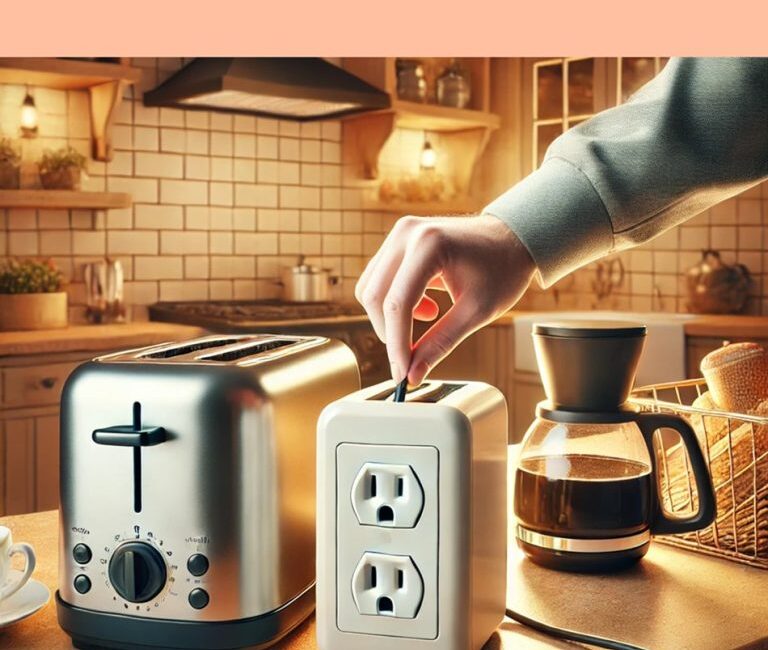In today’s world, where convenience and ease are often the driving forces behind our daily routines, household appliances have become an integral part of our lives. Toasters, coffee makers, microwaves, and other electronic devices are essential in our kitchens, providing us with quick, efficient solutions to prepare our favorite foods and beverages. However, there’s one crucial habit that many of us may not realize is impacting our home—leaving these appliances plugged in when not in use.
It seems harmless enough to leave a toaster, coffee maker, or blender plugged in, especially since they are not constantly operating. However, there’s an underlying reason why experts recommend unplugging appliances when they are not in use. By not adhering to this simple yet vital practice, we could be unknowingly increasing our energy bills, shortening the lifespan of our appliances, and even exposing ourselves to potential safety risks. In this article, we’ll discuss the surprising consequences of leaving appliances plugged in, the science behind it, and practical tips for adopting a more energy-efficient and safe approach to managing household appliances.
The Hidden Dangers of Leaving Appliances Plugged In
Let’s start by understanding the consequences of leaving appliances plugged in when not in use. You may be surprised to learn that it’s not just about energy consumption—there are several factors to consider when determining whether it’s worth it to leave that toaster or coffee maker plugged in.
1. Energy Drain and Increased Utility Bills
One of the most significant reasons to unplug appliances when not in use is to avoid what is known as “phantom power” or “standby power.” Phantom power refers to the electricity consumed by devices that are plugged into an outlet but are not actively in use. Many modern appliances, including toasters, coffee makers, and microwaves, consume small amounts of energy even when turned off. This happens because they remain in a low-power standby mode, waiting for the next use. Over time, this standby power usage can add up and contribute to higher electricity bills.
According to the U.S. Department of Energy, appliances that draw power when not in use can account for as much as 10% of your home’s total energy consumption. While the individual cost per appliance may seem negligible, the cumulative effect of leaving multiple devices plugged in can add up to a significant portion of your monthly electricity bill. Common household items like toasters, coffee makers, chargers, and televisions are some of the main culprits of this hidden energy drain.
2. Shortened Appliance Lifespan
When appliances are plugged in continuously, they are exposed to the constant flow of electricity, which can eventually lead to wear and tear on the internal components. Just as we would turn off a light to prevent it from using unnecessary energy, unplugging appliances can help prevent overloading circuits and prevent gradual damage to sensitive parts like wiring and circuitry.
Over time, appliances like coffee makers and toasters can become less efficient if left plugged in too often. In particular, the heating elements in toasters can experience wear from constant electrical flow, which can reduce their ability to heat food efficiently. Similarly, coffee makers may experience faster deterioration in their internal components if left plugged in without use. Replacing appliances earlier than necessary due to unnecessary damage can result in higher costs over time.
3. Fire Hazard Risk
While the chances may be slim, leaving appliances plugged in does introduce a fire risk. Electrical malfunctions can occur even when an appliance is not in active use. A defective cord, a faulty power switch, or damaged internal wiring can lead to overheating or sparking, which in rare cases can start a fire. This risk is particularly relevant for older appliances that have seen better days or appliances that are not designed to remain plugged in 24/7.
The risk is further increased if the appliance is plugged into a damaged or outdated outlet. Electrical outlets that have worn-out wiring or improper grounding can pose a significant fire hazard when used with high-powered kitchen appliances. By ensuring that appliances are unplugged when not in use, you reduce the possibility of electrical fires and ensure that appliances don’t become a latent hazard in your home.
4. Increased Carbon Footprint
As we become more conscious of our impact on the environment, energy consumption and its carbon footprint are critical concerns. Every time you leave an appliance plugged in, even if it’s in standby mode, it contributes to carbon emissions. The electricity used to power appliances often comes from non-renewable energy sources, which release greenhouse gases into the atmosphere. By reducing phantom power consumption by unplugging appliances, you can actively lower your home’s overall energy consumption and decrease your carbon footprint.
While one appliance might not have a significant effect on the environment, the cumulative effect of thousands of households leaving their appliances plugged in every day can contribute to climate change. Making small changes, such as unplugging unused appliances, helps to promote energy conservation and reduce harmful emissions.
5. Electromagnetic Radiation Exposure
Though the topic of electromagnetic radiation (EMF) exposure is still a matter of debate, some studies suggest that prolonged exposure to EMF may have adverse health effects. Many appliances, especially electronic devices, emit low levels of electromagnetic fields when plugged in. While the scientific community continues to research the long-term impact of EMF exposure, some individuals prefer to take precautionary measures to limit their exposure, including unplugging electronic devices when not in use.
Though it is still inconclusive whether EMFs from kitchen appliances pose significant health risks, there is no harm in reducing your exposure to potential radiation by simply unplugging devices when they are not needed.
Common Household Appliances and Phantom Power
Now that we understand the potential risks associated with leaving appliances plugged in, let’s take a closer look at common household items that contribute to phantom power and energy waste. Many people don’t realize how much energy is being consumed by appliances that are not actively in use. Here are some of the top offenders:
1. Toasters
Toasters are one of the most commonly used kitchen appliances, often relied upon for quick breakfasts or snacks. However, like many other kitchen gadgets, toasters continue to consume power when plugged in, even when not in use. Although the power consumption of a toaster in standby mode is relatively low, it still contributes to phantom energy consumption. Furthermore, leaving the toaster plugged in can reduce the appliance’s lifespan over time, as the internal components are continually exposed to electricity.
2. Coffee Makers
Coffee makers are another kitchen staple that many people leave plugged in without thinking. Even when turned off, coffee makers draw power from the outlet to maintain their standby mode. In addition, certain coffee makers may have features like clocks or timers that require electricity to keep running. By leaving a coffee maker plugged in, you are essentially allowing it to waste electricity, increasing your energy consumption without realizing it.
3. Microwaves
Microwaves are frequently used for reheating food or cooking meals, but many people don’t realize that even when they are not in use, they consume energy. This is especially true for microwaves with digital displays, clocks, or other features that require electricity to remain operational. As with other appliances, unplugging the microwave when not in use can help prevent energy waste and prolong the life of the appliance.
4. Chargers (Phone, Tablet, Laptop)
Chargers for devices such as smartphones, tablets, and laptops are notorious for drawing power when plugged in, even if the device is not connected. This phenomenon, known as “vampire power” or “energy vampires,” can waste considerable energy over time. Unplugging chargers when not in use or using a power strip with an on/off switch can help eliminate unnecessary power consumption.
5. Televisions and Entertainment Devices
Many people leave their televisions, gaming consoles, and entertainment devices plugged in after use. These devices can consume a surprising amount of energy when not in active use, especially if they are connected to external speakers, DVD players, or cable boxes. A simple solution is to unplug the devices after use or use a power strip to make it easier to disconnect them all at once.
How to Break the Habit and Save Energy
Now that we know the risks of leaving appliances plugged in, how can we break the habit and start saving energy? Here are some practical tips to help you make your home more energy-efficient:
1. Get into the Habit of Unplugging
Set reminders or develop a routine where you unplug appliances when not in use. For example, make it a habit to unplug your toaster and coffee maker after every breakfast. Consider using a small timer or alarm to remind you to check that appliances are unplugged at the end of the day.
2. Use Power Strips
One of the easiest ways to manage multiple devices is to plug them into a power strip with an on/off switch. When you’re done using appliances, simply switch off the power strip to cut off electricity to all connected devices at once. This is especially useful for devices like televisions, gaming consoles, and microwaves.
3. Consider Smart Plugs
Smart plugs are a great investment if you want to automate your energy-saving efforts. These plugs allow you to control appliances remotely through an app on your phone, meaning you can easily turn off appliances that are plugged in but not being used.
4. Invest in Energy-Efficient Appliances
If you’re in the market for new appliances, look for energy-efficient models that consume less power overall, even when in standby mode. Many modern appliances come with energy-saving features that can help minimize phantom power consumption.
Conclusion
Leaving appliances like toasters and coffee makers plugged in when not in use might seem harmless, but it can have a significant impact on your energy bills, the lifespan of your appliances, and even your safety. By becoming more mindful of phantom power, unplugging devices when not in use, and adopting energy-efficient habits, you can save money, reduce your carbon footprint, and ensure the longevity of your household appliances.
By implementing simple changes, such as using power strips, unplugging unused appliances, and investing in energy-efficient products, you can significantly reduce unnecessary energy consumption and help protect both your finances and the environment. The next time you walk past your plugged-in toaster or coffee maker, take a moment to unplug it—it’s a small habit with big benefits!




